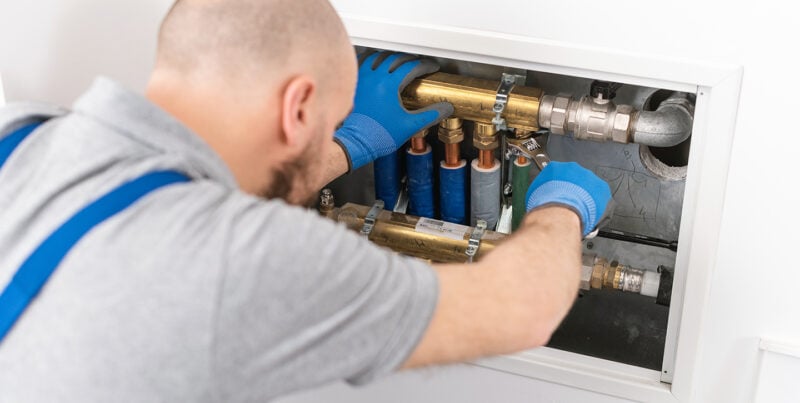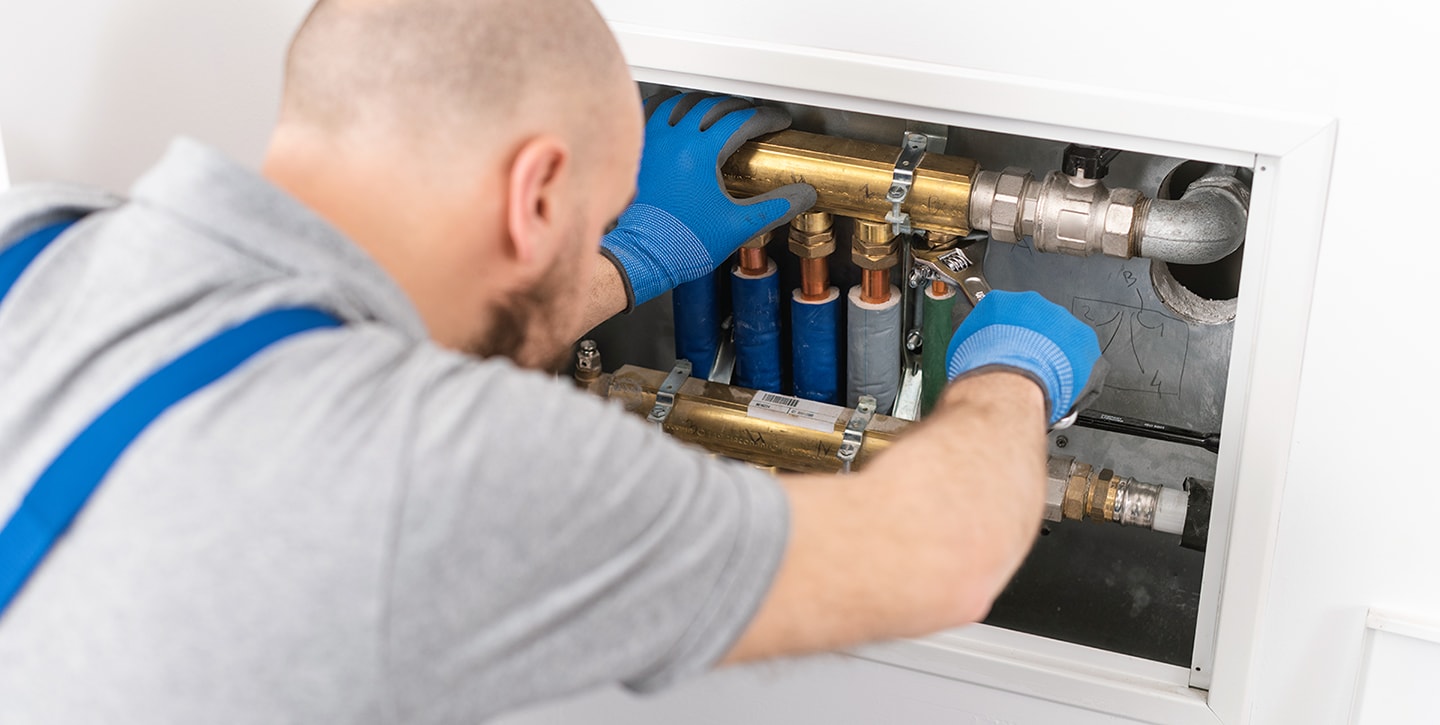When the peace of your home is shattered by water damage, the need for plumbing repairs becomes painfully clear. Life is interrupted when the heart of your home, the plumbing, needs to be renewed – the work is unavoidable and urgent.
Plumbing renovation affects everyday life and housing, but careful planning lays the foundations for a smooth process, and anticipation helps keep disruption to a minimum.
Cost factors for pipe rehabilitation
The price of a plumbing renovation is determined by many factors, such as the age of the building, the condition of the plumbing, the specific requirements of the site and the type of renovation chosen. Any asbestos demolition work, the choice of materials for the pipes to be replaced and any additional work required will also have a significant impact on the final cost. Plumbing renovation can also include more extensive measures, such as the renewal of the heating system or the complete replacement of domestic hot water pipes, which increase the cost of the project.
It is challenging to give an accurate price estimate without a site visit and a survey by an expert. Still, it is possible to mention that the cost of a single-family house plumbing renovation typically ranges from tens of thousands of euros to over a hundred thousand, depending on the factors mentioned above and the scope of the project.
Scope and methods of renovation
The scope of the renovation determines the methods chosen: from partial to whole-house renovation. Typically, water, sewer and heating pipes are renovated or replaced.
The coating method, where old pipes are coated on the inside with a new material, is suitable for situations where the pipelines are still in good condition. The implementation time is shorter and the costs lower than a complete replacement.
A well-planned renovation can significantly increase the value of your property and improve your living comfort.
Renovating pipes requires careful work by professionals: from design to implementation is often a multi-stage process. It is important to take into account the properties of the materials and the regulations in force that guide the choice of methods and the implementation of the renovation.
Material choices and their impact on price
The materials used have a significant impact on the overall cost of the pipe renovation, as well as their durability and freedom from maintenance. Different material options, such as copper, plastic or composite materials, each have their own price and efficiency.
There is a wide range of pipe materials on the market, which is reflected in price fluctuations. Durability and installability are key selection criteria.
In addition to the material of the pipes, other components such as fittings, valves and insulators also contribute to the total cost. It is important to assess, in the context of an overall plan, which combination of materials will ensure the best end result and return on investment, taking into account both the initial installation and possible future maintenance.
Material choices are also influenced by the specific conditions of the property, such as water quality, operational needs and the structural characteristics of the building. Properly selected materials can ensure the longevity and functionality of the plumbing system, but may increase the initial cost of the repair. In the long term, however, high-quality materials can reduce maintenance costs and improve comfort.
Labour’s share of the cost
In addition to materials, the total cost of a plumbing renovation is essentially based on the labour component. Installation by professionals is a high-quality, durable choice that will ensure your plumbing system will work for years to come.
The cost of the work can vary significantly depending on the scale of the project, the complexity of the work and the specialisation of the professionals involved. A plumbing repair by an experienced professional is an investment that minimises the additional costs that may arise in the future in the form of leaks and other defects. High-quality work also minimises the need for remedial action that can result from using unskilled labour.
It should also be noted that a specialised workforce that is familiar with current regulations and installation techniques may demand higher remuneration for their skills. However, this is justified, as they are able to ensure the technical functionality and suitability of the pipelines for future needs, in line with current regulations.
Ultimately, it is important to understand that while the labour element may seem like a large investment at the outset, it is a significant factor in the success and sustainability of a pipe rehabilitation project. Investing in skilled labour will pay off in reduced maintenance needs and a reliable water system in the home, increasing the value of the property and the long-term comfort of living there.
Financing options for pipe renovation
Financing a pipeline renovation is an important part of ensuring the success and financial sustainability of the project. Alternative ways of financing include using savings, a bank loan or various types of renovation loans. It is important to compare the interest rates and costs of different loan options and choose the one that best suits your financial circumstances. In certain cases, it is also possible to receive a household allowance, which can reduce the total cost of the renovation.
When planning your financing strategy, it is a good idea to identify the terms offered by different financiers and possible flexibility in the payment schedule. Consulting financial experts can be valuable in making decisions, and many banks offer special services for financing home renovations. This will ensure that the cost of the renovation does not exceed your budget.
Funds accumulated by the housing company
The finances of a housing company have a major impact on the financing of a renovation.
In the management of blocks of flats and terraced houses, housing association funds are essential. These funds usually consist of management contributions paid by shareholders, part of which is earmarked for the future needs of the company. Such earmarked funds are called a repair reserve fund or a future repair fund. The money accumulated in the funds can be used to finance major renovation projects such as plumbing renovation.
Funding is a long-term way of managing your finances.
Systematic funding creates financial security for the housing company. The savings are intended to prepare for future renovations, such as plumbing, by reducing the need to take out a loan. This helps to keep association fees low and increases the attractiveness of the housing association.
The impact on shareholders’ contributions is significant.
The amount of funds collected contributes to the amount of contributions that shareholders will have to pay for the renovation of the pipes. A well-funded housing association can cover a significant part of the renovation costs from its reserves, which in turn reduces the personal financial burden on shareholders. However, this requires continuous and disciplined management of the housing company’s finances.
Bank loans and financial institutions
Plumbing renovation often requires significant financing.
The cost of renovating pipes is significant, and often financing is arranged through a bank loan. The terms and interest rate of a loan depend on a number of factors, such as the borrower’s ability to pay and the collateral. Banks offer their customers different financing options, from which they can choose the most suitable solution. The length of the repayment period and the cost of the loan are key factors to consider.
Interest rates affect the repayment of the loan.
When taking out a bank loan, you need to look at the interest rates – whether it is a fixed or variable rate. A fixed rate provides predictability and protection against interest rate rises, while a variable rate can either increase or decrease the burden of payments over time.
Choosing the right loan period is important.
The duration of the loan affects the monthly repayments and the total cost of the loan. A shorter loan term usually means higher monthly repayments, but the overall cost is lower. If you choose a longer loan term, your monthly payments will decrease, but your interest costs will increase in the longer term.
Preparation and negotiation are key.
Well in advance of the repair, it is advisable to start negotiations with banks and other financial institutions to find the best possible financing solution. Actively taking steps to arrange financing and comparing multiple offers will help you achieve favourable loan terms and keep your finances under control in the future.
State aid options
You can find financial help to finance your plumbing renovation by exploring the government’s subsidy options. ARA, the Housing Financing and Development Agency, offers grants and loans under certain conditions.
For example, ARA’s renovation and energy grants are intended for renovating old detached houses and improving the energy efficiency of housing. The aim of these grants is to promote safe, healthy and energy-efficient housing.
Repair grants are applied for from ARA and are awarded based on a number of factors, such as the overall financial burden, the condition of the dwelling and the urgency of the need for repair. Particular attention will be paid to the housing needs of elderly and disabled people.
A state guarantee is also available for a pipe repair loan, which can lower the interest rate and improve the terms of the loan. With this guarantee agreement, the state takes on part of the risk of repaying the loan, making it easier to obtain a loan.
Before committing to a pipe renovation, it is advisable to consult the guidelines published on the ARA website to see if you qualify for grants or guarantees. This could provide you with significant financial help towards the cost of your plumbing repairs.
The impact of pipe renovation on everyday life
Renovating pipes is a major operation that affects the daily routines of living. It is essential to consider that during a pipe renovation, it is typically not possible to use the property’s normal water points, which means water outages and possibly also a temporary move away from the property being renovated. In addition, the renovation of pipes can cause noise pollution and dust, which requires residents to be adaptable and patient. It is advisable to plan in advance how everyday activities will be organised during the renovation so that the quality of life does not deteriorate significantly.
Temporary accommodation during renovation
A plumbing renovation may require you to move to another home for the duration of the renovation. This must be taken into account at the design stage.
- Explore options early on, such as rented accommodation or living with relatives.
- Carefully budget the cost of temporary accommodation in your renovation estimate.
- Remain flexible to changing schedules and be prepared for possible delays.
The temporary housing provides a safer environment for everyday activities while the renovation is underway.
Preparing in good time reduces the stress caused by renovation and helps everyday life to run smoothly.
Restrictions on the use of services and facilities
During a plumbing renovation, the essential functions of your home may be temporarily interrupted. For example, domestic water will be cut off during the plumbing works, which means restrictions on the daily water supply.
In particular, restrictions on the use of bathroom and kitchen facilities pose a significant challenge to the occupants of a detached house. When the water and sewerage systems were replaced, the use of these premises was blocked for long periods. It is important to plan in advance alternative solutions for daily activities such as cooking and washing.
Residents should be provided with clear instructions on when and how to access services at different stages of the renovation. Information must be up-to-date and easily accessible so that residents can plan their daily lives effectively and avoid unnecessary harm.
Sometimes it is possible to arrange for temporary substitutes, such as portable toilets or shower containers, if renovations prevent the use of sanitary facilities for more than a few days. It is important that these solutions are safe, hygienic and meet the basic needs of the residents. Arranging temporary replacement services is part of a serious planning exercise that should start well in advance of the renovation.
Noise nuisance and management
Renovating pipes also inevitably brings noise pollution, which can have a significant impact on living comfort. It is important to identify the different sources of noise and try to minimise their impact.
- Limiting working hours to permitted noise periods will reduce disturbance.
- Sound-insulating partitions can limit noise from the construction site to residential areas.
- Even optimising working practices during the working day can reduce noise levels.
- Informing residents about upcoming noisy work will help them to prepare in advance.
- Personal protective equipment, such as earplugs, provides temporary relief.
Taking into account regional regulations and the wishes of residents, working hours can be planned to minimise disruption.
A comprehensive noise management plan is part of a responsible plumbing renovation project that takes into account the needs of the residents and the requirements of the work.
Growth and energy efficiency
Plumbing renovation is an investment that has a positive long-term impact on the value of a property. Replacing outdated plumbing prevents potential damage and thus protects the value of your property. In addition, up-to-date plumbing can increase the energy efficiency of a property, which is a significant factor in the value of a home today.
Improving energy efficiency through pipe renovation can also lead to lower heating costs and an improvement in energy efficiency class. This can lower the cost of living and make the property more attractive to potential buyers. A properly executed pipe renovation can therefore be a significant competitive advantage in the market and bring savings to its owner in the long run.
The impact of plumbing renovation on the value of the dwelling
A pipe renovation is a major operation that can significantly increase the market value of a property. Upgraded water and sewerage systems are an important element in determining value, as they are a key part of the building’s infrastructure.
The value added depends on a number of factors, such as the extent of the renovation and the way it is carried out.
A properly carried out plumbing renovation gives buyers peace of mind, as they can trust the condition of the plumbing in their building and avoid unexpected costs in the future. In addition, new plumbing can bring additional benefits, such as better water pressure and water quality, which increases the comfort of living and thus the attractiveness of the property.
In an overall assessment, a plumbing renovation affects the market value of a home in many ways: it improves the condition of the property, increases home safety, reduces the risk of future damage and insurance costs, and can also improve energy efficiency. All these factors are likely to increase the interest and willingness of potential buyers to invest in the property. It is therefore essential to consider not only the immediate costs of a pipe renovation, but also the potential long-term value added.
Energy savings with new pipes
The installation of new pipes will bring significant energy savings. Modern pipe materials are more efficient at keeping the water temperature constant, which reduces heat loss.
Pipes with a higher insulation capacity minimise heat transfer to the surrounding space, which is particularly important, for example, for water and heating pipes in cold rooms. The new pipes will also allow the design and optimisation of the domestic water cycle to reduce unnecessary heating and water consumption. This means that the renovated piping system can reduce unnecessary energy consumption and thus save significantly on heating costs.
Furthermore, when domestic hot water is produced and distributed efficiently, the running time and energy demand of the waterproofing system is reduced. This leads directly to energy savings, which in turn reduces the energy costs of the whole house. As an added benefit, new piping often also allows for more precise control of domestic hot water temperature, reducing the need to overheat water and promoting energy efficiency.
Ultimately, energy-efficient plumbing renovation can also lead to better indoor air quality. Even distribution of hot water and properly insulated pipes reduce the risk of condensation, which prevents the risk of moisture damage. These factors add value to the property and contribute to a healthier living environment. Energy savings are therefore a significant advantage when evaluating a renewed pipeline, offering long-term economic benefits as well as an environmentally friendly solution.
Environmentally friendly materials and technologies
When renewing pipelines, attention should be paid to the environmental impact of materials and their life cycle. Sustainable and recyclable materials such as copper and steel reduce the environmental footprint of the renovation.
Water-friendly innovations such as low-emission pipe insulation are also on the market.
Plumbing modernisation can include the use of solar hot water heaters, which reduce the need for fossil fuels and reduce greenhouse gas emissions. The latest technologies offer opportunities for energy recovery from waste water, for example, which is more efficient and environmentally sustainable.
Products and technologies should be chosen to last over time and have a low environmental impact throughout their life cycle. Such choices can improve the energy efficiency of a household and reduce emissions. They also support the sustainable development of the building and increase the long-term value of the property. Energy efficiency and environmental friendliness are not only economically viable, but also reflect responsibility towards the environment and future generations.


















































































